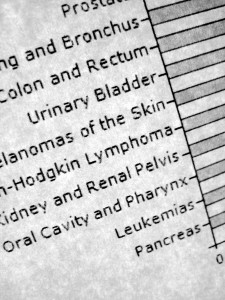Cancer is a disease whereby cells divide and grow abnormally, often spreading throughout the body and invading other organs and tissues. According to the National Cancer Institute (NCI), there are over one hundred different types of cancers with the main categories being 1) carcinoma, 2) sarcoma, 3) leukemia, 4) lymphoma and myeloma, and 5) central nervous system cancers. Most people know someone who has battled or is currently battling cancer. It is not surprising that most people mistakenly believe that cancer rates are on the rise, but just the opposite is true. The National Cancer Institute’s Cancer Trends Progress Report for 2009/2010 reveals that death rates for lung, breast, prostate, and colorectal cancers, the four cancers that occur the most frequently, are on the decline. In fact, death rates for all cancers combined continue to go down. The report indicates that the number of people getting cancer has continued to go down since about 2000. Historically speaking, the incidence of cancer increased from the mid 1970’s to about 1990, then leveled off for the next ten years or so, and has been on the decline since. It is important to note that rates for some cancers are on the rise. Those would include esophagus, pancreas, liver, bile duct, testis, kidney, leukemia, thyroid, melanoma of the skin, and childhood cancer. Cancer is the second leading cause of death in the United States; heart disease is the first. The Centers for Disease Control and Prevention reported that in 2007, 616,067 people died of heart disease and 562,875 people died of cancer. The NCI report also stated that blacks had the highest rate of new cancers, followed by whites, with lower rates for Hispanics and Asians. If you want to try and reduce your risk of getting cancer, avoid smoking, eat a healthy balanced diet, engage in regular physical activity, and maintain a normal weight.
Reference:
National Cancer Institute, U.S. National Institutes of Health. Cancer Trends Progress Report–2009/2010 Update. http://progressreport.cancer.gov/. Accessed 7-21-10.

